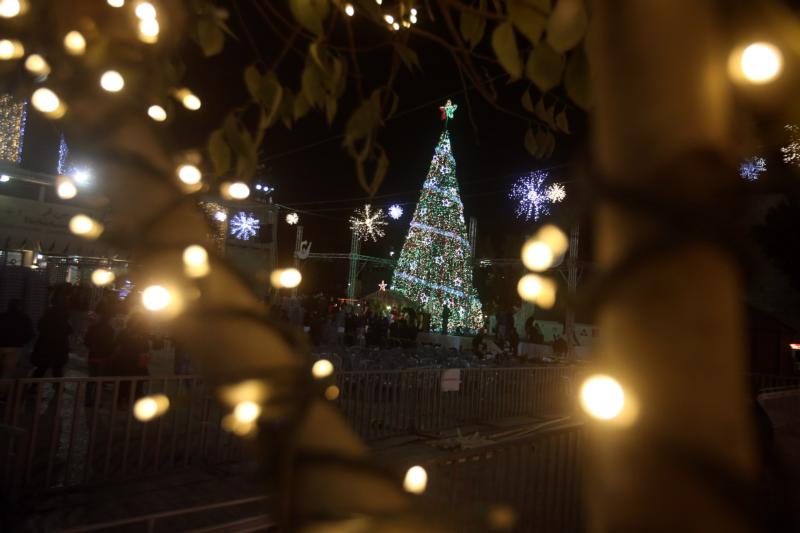Light in the darkness: war in the Holy Land brings the Incarnation into clearer focus
An apocryphal story, one of my favourites, has been doing the rounds in diplomatic circles for decades. Late one Advent in the middle of the Cold War, the British ambassador to Washington received a call from a local news station, and answered it himself. “Your Excellency,” said a voice at the other end of the The post Light in the darkness: war in the Holy Land brings the Incarnation into clearer focus appeared first on Catholic Herald.

An apocryphal story, one of my favourites, has been doing the rounds in diplomatic circles for decades. Late one Advent in the middle of the Cold War, the British ambassador to Washington received a call from a local news station, and answered it himself. “Your Excellency,” said a voice at the other end of the line, “what would you like for Christmas?”
“I couldn’t think of accepting anything,” he dutifully replied, but the caller persisted. “You have been so kind to us this year; do please tell us.” Trying to clear his desk and finish signing the last of the embassy Christmas cards, but also not wanting to cause offence, the ambassador gave in. “Fine. What about a small box of crystallised fruit?”
He thought no more about it until Christmas Eve, when he turned on the news. “We asked three ambassadors what they would like for Christmas,” the anchor announced. “The French ambassador wanted peace on earth; the German ambassador wanted greater understanding between nations… and the British ambassador wanted a small box of crystallised fruit.”
I long for the story to be true. As for me, I have already received an early Christmas present from the lovely people at Archangel Distilleries: a bottle of “Cardinalis”, the latest addition to their range. It is red, obviously, and best treated like port – I commend it to you. Meanwhile, I secretly covet a GK Chesterton Christmas tree bauble, which I saw on the internet.
As ever, worldly considerations intrude themselves into the annual preparations for the Nativity. There are presents to be wrapped; the butcher to be visited; Father’s offering to be placed in its special envelope; beds to be made. A bumper Sabbath of double church beckons, with Christmas Eve this year being also the Fourth Sunday of Advent.
The danger of forgetfulness also lingers; forgetfulness of the visceral nature of the Incarnation – of the scandalous outpouring of grace that sees God stoop down to embrace His creation, gone so far astray from His purposes in wilfulness and rejection of His love. Perhaps this year it will be easier to remember, but for reasons of heartbreak and not of joy.
It will surely be impossible to hear the story of the Nativity retold in sundry ways without one eye on the burgeoning death toll brought about by the most recent outbreak of violence in the Holy Land which, at the time of writing, shows no sign of abating. “O Little Town of Bethlehem / how still we see thee lie” may well seem hollow in the cold December air, even far away from the thundering of rockets and the crying of terrified children.
That said, Phillips Brooks’s carol, written in 1868, and sung to different tunes on both sides of the Atlantic – the American one all schmaltzy and saccharine, the English version more straightforward and foursquare – reflects deep truths that transcend the horrors of war. Brooks was an Episcopalian, a huge man who spent 20 years as rector of Trinity Church in Boston, MA, before dying relatively young in 1893 as Bishop of Massachusetts.
Despite being firmly of a “low-Church” tradition, Brooks was one of those Anglicans who held a Catholic view of the Incarnation; just as Charles Wesley, brother of John, wrote hymns on the Eucharist that can be – and often are – sung without hesitation at Mass and at Benediction of the Blessed Sacrament. For now the quiet Christmas night of the kind that Brooks envisaged is the luxury of those of us who do not live in in a war zone.
Nevertheless, the message of his carol endures, despite the fact that there is unlikely to be much deep and dreamless sleep in Bethlehem. “Yet in thy dark streets shineth / the everlasting light / the hopes and fears of all the years / are met in thee tonight.” Hopes and fears is about right, and the contrast of light and darkness in the prologue to St John’s Gospel comes into its own again: the light shines in the darkness, and the darkness has not overcome it.
The light is light, and the darkness is darkness. No snow-and-choristers chocolate-box picture can change that reality this Christmas, nor at any other – it was also true when the Holy Family fled to Egypt and the Innocents received their baptism of blood: martyrs in deed but not in will. Good is good and evil is evil, and while we know that good may overcome evil, more often than not it seems that evil triumphs over the good.
God knows this too, of course; He tells us from the Cross. He deigns to stoop to our level and to enter the human story; to live alongside us with all our imperfections, all our sin, all our greed, all our seeming determination to mar His image in ourselves and in each other. And yet he does it: the Word was made flesh and dwelt among us, full of grace and truth. Though the darkness be great and the light seem small, there is yet hope – and so we pray.
The post Light in the darkness: war in the Holy Land brings the Incarnation into clearer focus appeared first on Catholic Herald.














